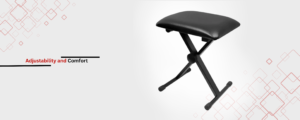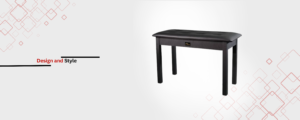The piano bench is often overlooked as an accessory that comes with the instrument, but it undeniably plays a strong role in enhancing comfort, posture, and performance quality. Anything below standard construction puts one at risk of discomfort, instability, and getting a bench that will deteriorate easily. Practice sessions become complicated and playing stops being enjoyable. To avoid these scenarios, it is vital to choose a bench that best combines durability, ergonomics, and aesthetics. In the below article, we have tips so that the decision process is as effortless as possible.
To know more, read, Why a Good Piano Bench Matters More Than You Think
Material Considerations
The construction materials impact the durability of a piano bench and are one of the major determinants. The best materials will always improve a bench’s construction quality, strength, and overall stability even.
Hardwood vs. Softwood:
Hardwoods like oak, maple, or mahogany are highly recommended due to their density and lack of warping. The softwood category, which includes pine or fir, is often prone to scratches and dents. A reasonable amount of use weakens the softwoods over time. A hardwood frame guarantees that the bench is sturdy enough, even with daily usage.
Metal Elements and Fittings:
Benches featuring metal parts, especially those in the form of reinforced steel frame benches, are important due to their tremendous strength and capacity to carry heavy loads. Moreover, the material for the hinges, screws, and bolts must be stainless steel to avoid corrosion and ensure preservation of strength.
Upholstery and Padding:
With upholstered benches, the best option is top-grain leather or high-density synthetic fiber since they are more difficult to damage. The padding under the upholstery should be made from high resiliency foam, as it retains shape better than lower quality options. The upholstery is stitched with double-stitched seams.
Need this in bulk? You can get this from wholesale – piano benches
If you need this at the best prices, you might check out this new platform – piano benches
Construction Quality
The accuracy of the cutting of the elements of the piano bench, coupled with its sturdy assembly, leads to a hinge that has finely crafted details. This precision focus is important as it extends the working life of the item for a number of years.
Joinery Methods:
Dovetail or mortise-and-tenon joints are some of the conventional joinery techniques that stand as high testaments for use in parts of a construction. These methods give better joints that hold the components together, unlike the use of bolts, screws, or glue that may loosen over time.
Weight Capacity:
Always check the specifications given by the manufacturer regarding weight capacity. Fewer people are likely to restrict the bench for use for 200-400 pounds as a practical range for most active people.
Adjustability and Comfort
Adjustable benches allow pianists of different heights and preferences to maintain proper posture while playing, reducing fatigue during long practice sessions.
Height Adjustment Mechanisms:
Like all other devices, benches need to be adjusted to required heights and stable at rest, which is where hydraulic or spindle-based adjustment systems come in with their ease of operation and reliability.
Padding and Ergonomics:
The bench should provide at least 2-3 inches of padding, which is adequate cushioning thickness. Moreover, the padding should be designed to offer contouring to the spine to minimize strain.
Design and Style
The aesthetics of the bench are equally important; there must be an excellent balance between the aesthetics of the bench and piano that are of greatest consideration while ensuring utmost durability.
Aesthetic Compatibility:
The color and finish of the bench should match the design of the piano as well. For instance, modern instruments are better suited with a metal frame, whereas traditional pianos are best paired with polished walnut benches.
Benches with Built-In Storage:
Aside from practicality, these types of benches are also excellent for enhancing durability. Nevertheless, the hinges and lids are better off being reinforced to withstand frequent opening and closing.
Maintenance and Care Tips
The functionality and aesthetics of the bench can be preserved with regular maintenance and just caring for the bench.
Month-to-Month Cleaning:
Wood surfaces must be dusted weekly and treated with appropriate polish for the wood’s specific finish. Approved products from the manufacturer may be used to clean fabrics via vacuuming and spot cleaning.
Environmental Remarks:
Avoid direct sunlight as well as high and low humidity levels because they might make wood split and upholstery lose its color. To maintain the bench for as long as possible, the ideal indoor environment is best.
Conclusion
The comprehensive ergonomic approaches to the material strength, construction, and shape of a piano bench determine its durability. 5 Core, Roland, On Stage and K&M are some of the most reputable brands known to strive on these matters. The bench’s longevity is also maintained through consistent maintenance practices that are reliable and aesthetically pleasing. Even when innovations in piano accessories are developed, one can always trust that products from these brands offer unbeatable quality, reliability, and freedom for musicians to embrace change.






